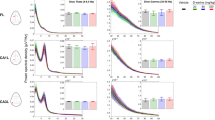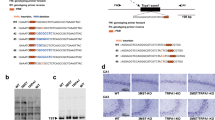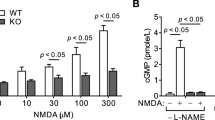Abstract
Hippocampal N-methyl-D-aspartate receptors (NMDARs) are thought to be involved in the regulation of memory formation and learning. Investigation of NMDAR function during experimental conditions known to be associated with impaired cognition in vivo may provide new insights into the role of NMDARs in learning and memory. Specifically, the mechanism whereby high concentrations of L-phenylalanine (L-Phe) during phenylketonuria (>1.2 mM) cause mental retardation remains unknown. Therefore, the effects of L-Phe on NMDA-activated currents (INMDA) were studied in cultured hippocampal neurons from newborn rats using the patch-clamp technique. L-Phe specifically and reversibly attenuated INMDA in a concentration-dependent manner (IC50 = 1.71 ± 0.24 mM). In contrast, L-tyrosine (L-Tyr), an amino acid synthesized from L-Phe in normal subjects, did not significantly change INMDA. Although the L-Phe-INMDA concentration-response relationship was independent of the concentration of NMDA, it was shifted rightward by increasing the concentration of glycine. Consistent with an effect of L-Phe on the NMDAR glycine-binding site, L-Phe (1 mM) did not attenuate INMDA in the presence of D-alanine (10 μM). Furthermore, L-Phe significantly attenuated neither glutamate-activated current in the presence of MK-801, nor current activated by AMPA. The finding that L-Phe inhibits specifically NMDAR current in hippocampal neurons by competing for the glycine-binding site suggests a role for impaired NMDAR function in the development of mental retardation during phenylketonuria and accordingly an important role for NMDARs in memory formation and learning.
This is a preview of subscription content, access via your institution
Access options
Subscribe to this journal
Receive 12 print issues and online access
$259.00 per year
only $21.58 per issue
Buy this article
- Purchase on Springer Link
- Instant access to full article PDF
Prices may be subject to local taxes which are calculated during checkout




Similar content being viewed by others
References
Kleckner NW Dingledine R Requirement for glycine in activation of NMDA receptors expressed in Xenopus oocytes Science 1988 214 835 837
Mayer ML Vyklicky L Clements J Regulation of NMDA receptor desensitization in mouse hippocampal neurons by glycine Nature 1989 338 425 427
Lerma J Zukin RS Bennett MV Glycine decreases desensitization of N-methyl-D-aspartate (NMDA) receptors expressed in Xenopus oocytes and is required for NMDA responses Proc Natl Acad Sci USA 1990 87 2354 2358
Chen NS Moshaver A Raymond LA Differential sensitivity of recombinant N-methyl-D-aspartate receptor subtypes to zinc inhibition Mol Pharmacol 1997 51 1015 1023
Johnson JW Ascher P Glycine potentiates the NMDA response in cultured mouse brain neurons Nature 1987 325 529 531
Sakata K Fukushima T Minje L Ogurusu T Taira H Mishina M et alModulation by L- and D-isoforms of amino acids of the L-glutamate response of N-methyl-D-aspartate receptors Biochemistry 1999 38 10099 10106
Morris RG Anderson E Lynch GS Baudry M Selective impairment of learning and blockade of long-term potentiation by an N-methyl-D-aspartate receptor antagonist, AP5 Nature 1986 319 774 776
Borroni AM Fichtenholtz H Woodside BL Teyler TJ Role of voltage-dependent calcium channel long-term potentiation (LTP) and NMDA LTP in spatial memory J Neurosci 2000 20 9272 9276
Rondi-Reig L Libbey M Eichenbaum H Tonegawa S CA1-specific N-methyl-D-aspartate receptor knockout mice are deficient in solving a nonspatial transverse patterning task Proc Natl Acad Sci USA 2001 98 3543 3548
Grunwald T Beck H Lehnertz K Blumcke I Pezer N Kurthen M et alEvidence relating human verbal memory to hippocampal N-methyl-D-aspartate receptors Proc Natl Acad Sci USA 1999 96 12085 12089
Knox WE PhenylketonuriaIn: Stanbury JB, Wyngaarden JB, Fredrickson DS (eds)The Metabolic Basis of Inherited Diseases, 3rd edn McGraw Hill: New York 1972pp266 295
Scriver CR Kaufman S Woo SLC The HyperphenylalanenemiasIn: Scriver CR, Beaudet AL, Sly WS, Valles D (eds)The Metabolic Basis of Inherited Disease McGraw-Hill: New York 1989pp495 546
Pennington BF van Doorninck WJ McCabe LL McCabe ER Neuropsychological deficits in early treated phenylketonuric children Am J Ment Defic 1985 89 467 474
Berry HK O'Grady DJ Perlmutter LJ Bofinger MK Intellectual development and academic achievement of children treated early for phenylketonuria Dev Med Child Neurol 1979 21 311 320
Dingledine R Borges K Bowie D Traynelis SF The glutamate receptor ion channels Pharmacol Rev 1999 51 7 61
Jervis GA Phenylpyruvic oligophrenia deficiency of phenylalanine-oxidizing system Proc Soc Exp Biol Med 1953 82 514 515
Kaufman S Tetrahydrobiopterin. Basic Biochemistry and Role in Human Disease Johns Hopkins Univ Press: Baltimore 1997pp1 342
McDonald JD Bode VC Dove WF Shedlovsky A Pahhph-5: a mouse mutant deficient in phenylalanine hydroxylase Proc Natl Acad Sci USA 1990 87 1965 1967
Shedlovsky A McDonald JD Symula D Dove WF Mouse models of human phenylketonuria Genetics 1993 134 1205 1210
Chandler LJ Sutton G Norwood D Sumners C Crews FT Chronic ethanol increases N-methyl-D-aspartate-stimulated nitric oxide formation but not receptor density in cultured cortical neurons Mol Pharmacol 1997 51 733 740
Hamill OP Marty A Neher E Sakmann B Sigworth FJ Improved patch-clamp techniques for high-resolution current recording from cells and cell-free membrane patches Pflugers Arch 1981 391 85 100
Patneau DK Mayer ML Structure-activity relationships for amino acid transmitter candidates acting at N-methyl-D-aspartate and quisqualate receptors J Neurosci 1990 10 2385 2399
Huettner JE Bean BP Block of N-methyl-D-aspartate-activated current by the anticonvulsant MK-801: selective binding to open channels Proc Natl Acad Sci USA 1988 85 1307 1311
MacDonald JF Bartlett MC Mody I Pahapill P Reynolds JN Salter MW et alActions of ketamine, phencyclidine and MK-801 on NMDA receptor currents in cultured mouse hippocampal neurones J Physiol 1991 432 483 508
Woodruff GN Foster AC Gill R Kemp JA Wong EH Iversen LL The interaction between MK-801 and receptors for N-methyl-D-aspartate: functional consequences Neuropharmacology 1987 26 903 909
Hanley WB Lee AW Hanley AJ Lehotay DC Austin VJ Schoonheyt WE et al‘Hypotyrosinemia’ in phenylketonuria Mol Genet Metab 2000 69 286 294
Laube B Hirai H Sturgess M Betz H Kuhse J Molecular determinants of agonist discrimination by NMDA receptor subunits: analysis of the glutamate binding site on the NR2B subunit Neuron 1997 18 493 503
Johnson JW Ascher P Equilibrium and kinetic study of glycine action on the N-methyl-D-aspartate receptor in cultured mouse brain neurons J Physiol 1992 455 339 365
Lerma J Kushner L Zukin RS Bennett MV N-methyl-D-aspartate activates different channels than do kainate and quisqualate Proc Natl Acad Sci USA 1989 86 2083 2087
Pan-Hou H Suda Y Ohe Y Sumi M Yoshioka M Effect of aspartame on N-methyl-D-aspartate-sensitive L-[3H]glutamate binding sites in rat brain synaptic membranes Brain Res 1990 520 351 353
Parsons CG Zong X Lux HD Whole cell and single channel analysis of the kinetics of glycine-sensitive N-methyl-D-aspartate receptor desensitization Br J Pharmacol 1993 109 213 221
Westergren I Nystrom B Hamberger A Nordborg C Johansson BB Concentrations of amino acids in extracellular fluid after opening of the blood–brain barrier by intracarotid infusion of protamine sulfate J Neurochem 1994 62 159 165
Berger AJ Dieudonne S Ascher P Glycine uptake governs glycine site occupancy at NMDA receptors of excitatory synapses J Neurophysiol 1998 80 3336 3340
Bergeron R Meyer TM Coyle JT Greene RW Modulation of N-methyl-D-aspartate receptor function by glycine transport Proc Natl Acad Sci USA 1998 95 15730 15734
Supplisson S Bergman C Control of NMDA receptor activation by a glycine transporter co-expressed in Xenopus oocytes J Neurosci 1997 17 4580 4590
Strupp BJ Levitsky DA Blumstein L PKU, learning and models of mental retardation Dev Psychobiol 1984 17 109 120
Zagreda L Goodman J Druin DP McDonald D Diamond A Cognitive deficits in a genetic mouse model of the most common biochemical cause of human mental retardation J Neurosci 1999 19 6175 6182
Trefz FK Burgard P Konig T Goebel-Schreiner B Lichter-Konecki U Konecki D et alGenotype-phenotype correlations in phenylketonuria Clin Chim Acta 1993 217 15 21
Acknowledgements
This study was supported by funding from the University of Florida McKnight Brain Institute, Howard Hughes Medical Institute and JS Gravenstein Endowed Professorship.
Author information
Authors and Affiliations
Corresponding author
Rights and permissions
About this article
Cite this article
Glushakov, A., Dennis, D., Morey, T. et al. Specific inhibition of N-methyl-D-aspartate receptor function in rat hippocampal neurons by L-phenylalanine at concentrations observed during phenylketonuria. Mol Psychiatry 7, 359–367 (2002). https://doi.org/10.1038/sj.mp.4000976
Received:
Revised:
Accepted:
Published:
Issue Date:
DOI: https://doi.org/10.1038/sj.mp.4000976
Keywords
This article is cited by
Suppression of exaggerated NMDAR activity by memantine treatment ameliorates neurological and behavioral deficits in aminopeptidase P1-deficient mice
Experimental & Molecular Medicine (2022)
Post-inflammatory behavioural despair in male mice is associated with reduced cortical glutamate-glutamine ratios, and circulating lipid and energy metabolites
Scientific Reports (2020)
Pd-catalysed ligand-enabled carboxylate-directed highly regioselective arylation of aliphatic acids
Nature Communications (2017)
Halogenated aromatic amino acid 3,5-dibromo-d-tyrosine produces beneficial effects in experimental stroke and seizures
Amino Acids (2011)
A Study of Gene Expression Profiles of Cultured Embryonic Rat Neurons Induced by Phenylalanine
Metabolic Brain Disease (2005)



